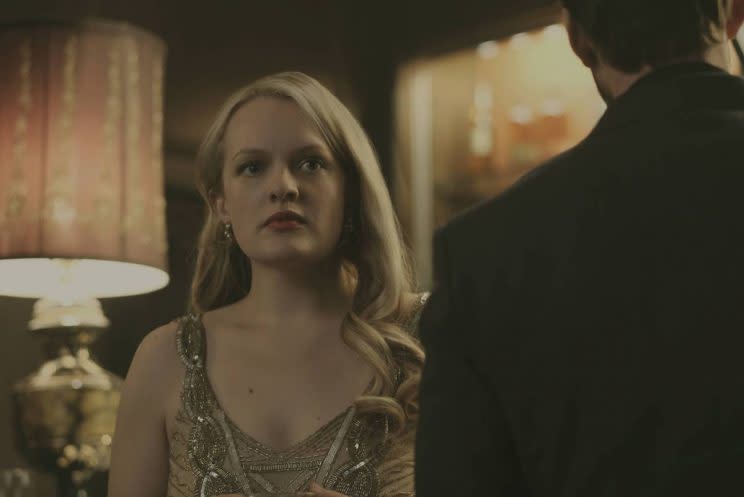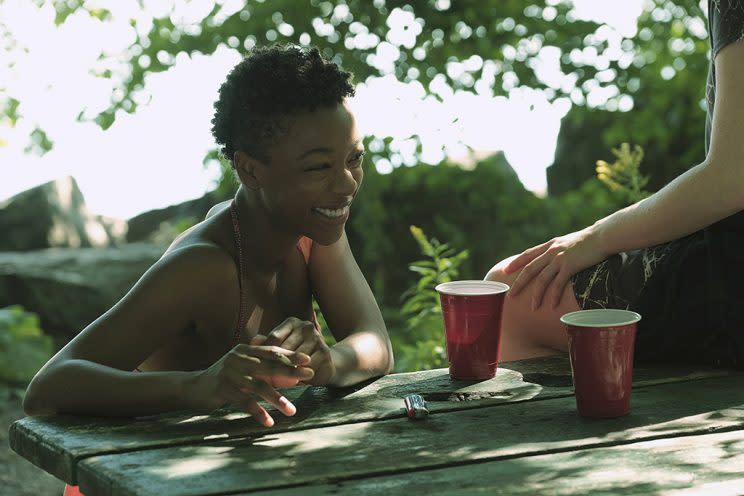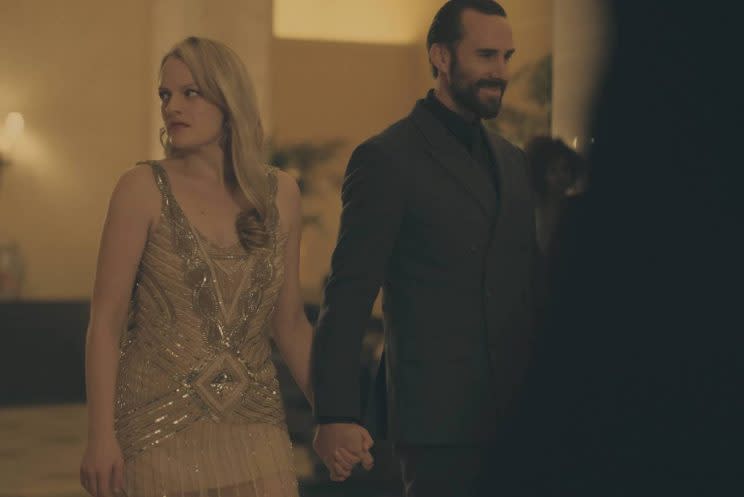‘The Handmaid’s Tale’ Postmortem: Samira Wiley Talks Her Unexpected Return

Warning: This post contains spoilers for the “Jezebels” episode of The Handmaid’s Tale.
Although a litany of horrors is described within its pages, The Handmaid’s Tale isn’t a conventional horror tale. There are no nightmarish monsters or masked serial killers stalking our heroine, Offred, as she navigates her daily existence in Gilead. What does place Margaret Atwood’s novel in the horror tradition, though, is the way she transforms familiar environments into alien territory. Because Gilead has been constructed on an existing world — repurposing preexisting public and private spaces instead of tearing them down and building on the bones — its citizens have to confront the eerie disconnect between the world that was and the world that is now on a daily basis.
Supermarkets where families once did their weekend shopping are now filled with Handmaids silently pushing their shopping carts through the aisles. A centuries-old wall (which Atwood has confirmed is intended to be the wall that encircles Harvard University) is used as a gallows, where dead bodies are displayed for passersby. And, in one of the book’s most famous sections, which now forms the basis of the eighth episode of Hulu’s serialized adaptation, a blandly corporate hotel becomes an after-hours brothel named Jezebel’s where Offred comes face to face with an actual ghost from her past: Moira.
Adding to the haunted house feel in the novel is the way Atwood describes Offred’s dawning realization of the place that Jezebel’s used to be. Ushered in through the back entrance, and then escorted by the Commander through a maze of corridors, she eventually ends up in the central lobby where she observes, a “round fountain [sprays] water in the shape of a dandelion gone to seed,” and “oval-shaped glass elevators slide up and down the walls like giant mollusks.” It’s at once both the same place she knows, and a world she’s never seen — an unsettling in-between feeling that accounts for why she processes an ordinary elevator as a giant mollusk.

The episode’s director, Kate Dennis, can’t directly translate such beautifully creepy turns of phrase to the screen, but she does visualize Offred’s entrance into Jezebel’s in a way that evokes horror movie classics like The Shining and Carnival of Souls. Walking through hallways that grow progressively more shadowy, Offred and Fred (Elisabeth Moss and Joseph Fiennes) emerge in a dimly lit waiting area, where she can only glimpse fragments of forbidden images through the gloom: a topless woman wearing a Handmaid’s cap, other women sporting makeup and lingerie. (The only discordant note in this hallucinatory sequence? The fact that it’s scored to Jefferson Airplane’s “White Rabbit,” a song that’s in desperate need of a five-year moratorium.)
But those sights pale in comparison to the bigger shock awaiting her when she lays eyes on Moira (Samira Wiley) from across the lobby; the bold woman who took it upon herself to bust loose of the Red Center is now just another working girl in Jezebel’s. “I walked onto that set and felt the line between creepy and eerie,” Wiley says. “It’s sort of like a circus, and it’s kind of gross! In a good way, though. A lot of these moments in our show are meant to make people feel uncomfortable, and not hide anything that the book presents. So it was gross, but also awesome, because we’re really telling the story that was meant to be told.”

That said, there are some subtle, but significant differences between Offred and Moira’s reunion in the series versus the novel. In both cases, Moira took a similar route to Jezebel’s, one that involved a thwarted flight out of the country and a choice between a temporary stay in the brothel or permanent exile to the colonies. As a result of that experience, the Moira that Offred encounters now is sapped of her will to fight back — the very thing that turned her into a symbol of hope for her friend. In the book, Offred tries to revive some of Moira’s steeliness as she recounts her story of escape and capture secondhand. “I’ve tried to make it sound as much like her as I can,” she says, straining to preserve some of Moira’s wry sense of humor and determination even in these tragic circumstances.
Wiley, on the other hand, doesn’t shy away from presenting Moira as a vulnerable, broken woman, which adds an added layer of fear to their reunion in the series. Not only is this hotel a place Offred no longer recognizes, her friend has changed almost beyond recognition as well. “In the book, we see Moira portrayed as such a rock; she’s immovable and determined,” Wiley explains. “Up until the end, she’s the person who is never going to give up. And that makes her someone that Offred looks up to in order to help her survive. Her memory of Moira really bolsters her. The thing that I wanted to try and explore that’s not so apparent on the page are those moments where Moira is vulnerable. Because as much of a hard-ass we want to be, we all have our breaking point. So I wanted to show moments where Moira melts, where she cannot be June’s rock.”
Wiley points to a flashback scene in the third episode, where June and Moira attend a protest rally only to be fired on by the soldiers who will soon enforce the rules of Gilead, as an early example of where the writers tried to chip away at her character’s stony exterior. “Jezebels” takes that further, with Moira melting into June’s arms, weeping, as they sit in the brothel’s overcrowded dormitory. And, in another reversal, June is the one who insists that her friend’s fight isn’t over yet. “We’re going to find a way to get you out of here,” she says, pointing to Luke as an example of a successful escape. (That’s more courage than she can muster than in the book, where her only encouragement is a half-hearted: “You don’t mean that.”) “This may not be how people instinctively think about [Moira’s] character,” Wiley says. “She’s definitely broken, and to see her in a position of defeat is unfamiliar. But there are still glimmers of who she is at her core. I wanted to make sure that I got all of Moira in that scene, and I hope I did a good job walking that line.”
Adding further resonance to the Jezebel’s section in the novel is the fact that Offred tells us she never sees Moira again after their clandestine reunion. But Wiley reveals that this isn’t her last episode, which does blunt some of the emotional impact their encounter carries on the page. “There’s a lot of things in the book that, as an actor, I question about why we’re making that choice — what does it give us to change that,” Wiley admits. “And over and over again, the writers explain it to me in a way that makes complete sense. We’re making an adaptation for television, and TV is about having a heightened portrayal of the story. In the beginning, there was a part of me that thought maybe [that choice] took something away, but now I see how much it adds. In the book, we see the whole story from Offred’s perspective. [In the show], we’re taking advantage of all these wonderful actresses who are so amazing and use their talent in ways we never saw before.”
Wiley also trusts the writers to decide whether or not they want to explicitly address a subject that’s flown under the radar all season long: whether any existing racial prejudices have found their way into the brave new world of Gilead. In Atwood’s original telling, the republic’s founders rid their community of other races, exiling them to certain death in the wastelands of the colonies. But series creator Bruce Miller made the conscious choice to make this version of Gilead a more inclusive society, operating under the assumption that a fertility crisis would give people cause to set old hatreds aside. Strangely enough, the lack of any pronounced racism within Gilead is the one utopian aspect of what’s otherwise one of TV’s most vividly realized dystopias.
At the same time, it’s hard to imagine that racism has been completely purged from this world, and a place like Jezebel’s — where men are invited to act out their darkest fantasies — would seem a place where it would rear its ugly head. “It’s not something that has been explored so far,” Wiley says. “But I do think the opportunity is there because of the choices Bruce has made. [The show] is reflecting a world we live in today; you can’t really escape the diverse world we live in, and to portray that in a dystopia is a very interesting choice. What’s most important in this world is continuing the human race. That trumps every single other thing.” (Let’s also not forget that, in the bigger picture, Gilead’s embrace of multiculturalism allows Miller to cast such terrific actors as Wiley and O-T Fagbenle, who wouldn’t have had the chance to be part of the ensemble in a more traditional adaptation of the book. Speaking with Yahoo TV last week, Fagbenle echoed Wiley’s sentiments that the show’s inclusiveness is more reflective of the modern world, while also adding, “Oftentimes, these prejudices are underlined and do find their way to the surface.”)

With two episodes left before the end of the first season, Wiley advises viewers to keep an eye on how the ramifications of June’s eerie first visit to Jezebel’s reverberate for all the characters, including Moira. “This encounter makes her see how much she needs to double down and live in this world without resistance,” the actress teases. “Up until now, she’s retained the essence of who she is, but in the next episode, she’s sort of made a complete transition.” Even as the bond between these two women strains, it never breaks. “There are so many people I met in college who are some of my best friends today,” Wiley says of the real-life analogs she draws on to depict June and Moira’s sisterhood. “What we went through in those years, becoming adults, we did that together. College is where June and Moira first met, and they bonded in a way that they’ve been each other’s rocks. Moira is strong in her convictions, and it takes a special person to be able to be by her side.”‘
The Handmaid’s Tale releases new episodes every Wednesday on Hulu.
Read more from Yahoo TV:
Summer TV Preview: The Scoop on 21 New Shows
Summer TV Preview: What’s Next For 17 Returning Shows
Kathy Griffin’s Offensive Trump Photo and the Fox News Snowflakes


